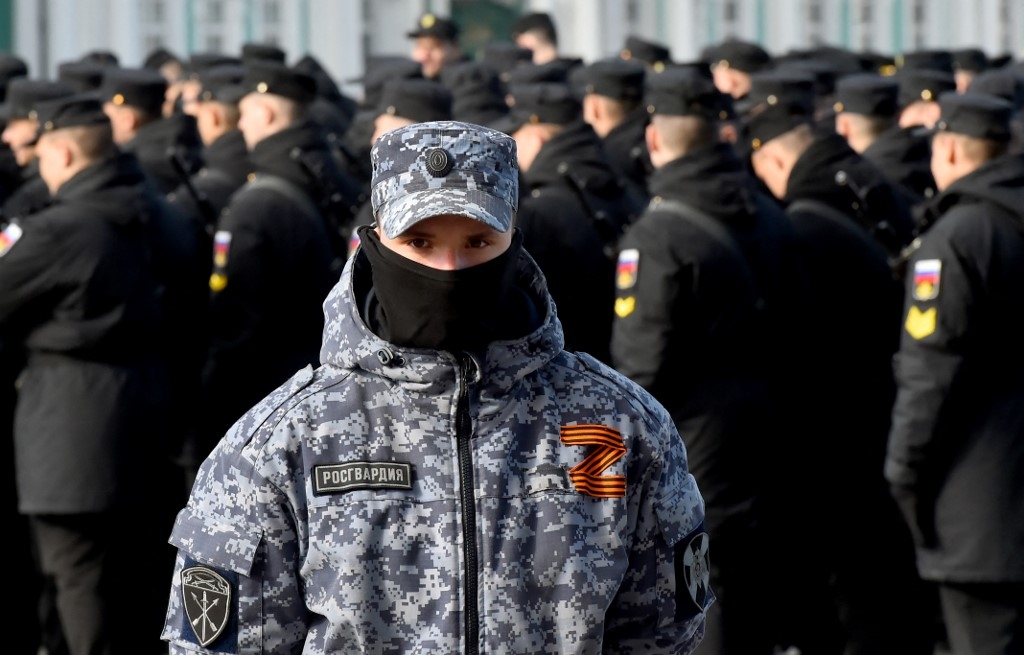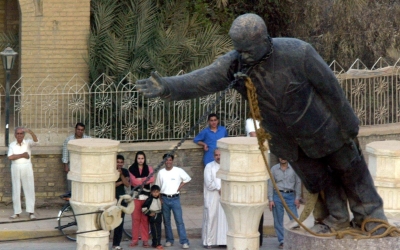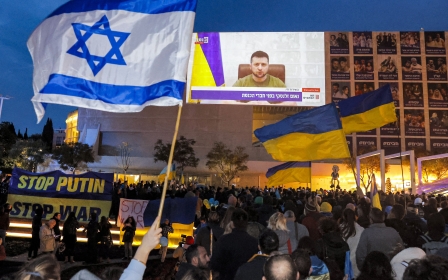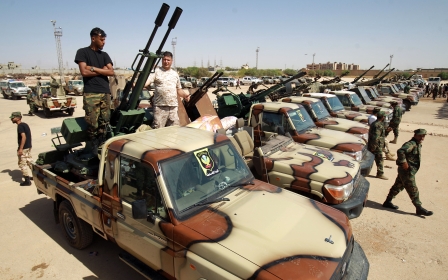How Putin’s army fights like Islamic State in Ukraine

In February 1993, former CIA director James Woolsey famously described the post-cold war environment by stating that the US and its allies slayed a large dragon (the Soviet Union) but ended up in a jungle full of snakes (warlords in failed states, terrorism and various substate threats).
David Kilcullen argued in a masterpiece that “dragons” (international and regional powers) can fight like “snakes” (substate actors) to enhance military effectiveness.
In Ukraine, Russian forces have employed both methods of warfare. It has employed tactics similar to those used by the so-called “Islamic State Organisation” (IS).
These tactics are ideology-free and combat effective. Many of them are prohibited and their results can amount to war crimes.
How Islamic State fights
New MEE newsletter: Jerusalem Dispatch
Sign up to get the latest insights and analysis on Israel-Palestine, alongside Turkey Unpacked and other MEE newsletters
IS and its predecessor, the Islamic State of Iraq (ISI), started their “special military operation” to occupy parts of Syria and Libya in 2011 and 2014, respectively. The organisation initially relied on covert operations to infiltrate both rebel and regime security and military structures, absorbing like-minded organisations and individuals, creating false-front civilian organisations, collecting intelligence (and “dirt”) on community leaders in targeted areas, all while initially denying its existence on the targeted territories.
Similarities can be found in methods of warfare employed by the Russian armed forces under Vladimir Putin and the combat units of IS
These operations were led by “agents-in-charge”: spymasters with kinetic assets and authority to assassinate, bomb, bribe, recruit, map-out targeted territories and designate local factions and communities. The most famous of these “agents-in-charge” was Samir al-Khlifawi, better known as Haji Bakr.
The modus operandi paid off. By September 2013, IS became the dominant armed organisation in Raqqa city by relying almost exclusively on urban terrorism tactics and infiltration operations. These actions were followed by raiding and looting parts of both the Assad regime’s and armed opposition’s conventional arsenals, which IS then modified, converted, and upgraded.
Similar modi operandi were executed in the Libyan city of Sirte in 2015 and selectively in a range of towns and cities from the southern Philippines to western Libya, and more recently in West Africa.
How Russia fights in Ukraine
"Good people, bad authority does not work [in Ukraine]. Recognition of this fact is the basis of the policy of denazification… The name ‘Ukraine’ apparently cannot be preserved as the title of any fully de-nazified state…Denazification will inevitably be de-Ukrainianisation.”
These excerpts from an infamous article published in the Russian state-controlled news agency RIA Novosti represent a type of propaganda which legitimates mass violence against non-conformist peoples and the liquidation of existing states. It is similar to types of propaganda employed in other modern historical contexts, including by IS.
The parallels between the tactics of Russia and IS do not end with propaganda, however. Other similarities can be found in methods of warfare employed by the Russian armed forces under Vladimir Putin and the combat units of IS.
As of February 2014 in Crimea and April 2014 in the Donbas, Russia and its local proxies relied on tactics that are very similar to those employed by IS and its predecessors between 2012 and 2014.
For instance, both Russia and IS have used false-front civilian organisations, kidnapping and assassinations, propaganda and disinformation campaigns, psychological warfare, and infiltrations of senior ranks. Initially, Russia didn’t admit to having employed these tactics (maskirovka), but neither did IS initially.
To secure its strategic gains, Russia executed one of the largest air-assault operations in the history of Eastern Europe in Crimea, a military capacity that IS never had.
Despite the gap in capacities, the combination of intense hybrid warfare followed by securing gains with a conventional force is a very IS-like modus operandi, executed several times in multiple cities, including Iraq’s Mosul in June 2014.
When Russia occupied the most important geostrategic region of Ukraine with minimum resistance by the end of March 2014, similar modi operandi were executed in several cities in Eastern Ukraine, including the Donbas region, in April 2014. These operations were led by some of the same commanders who led the invasion of Crimea, the most infamous of whom is Colonel Igor Gurkin.
The outcomes of these operations in Donetsk, Luhansk, Kharkiv, Dnipro and elsewhere ranged between partial and total failures. “Kharkiv People’s Republic” did not last 24 hours between 7 and 8 April 2014. Ukrainian Russian-speakers in Ukraine’s largest Russian-speaking city rapidly brought down Putin’s proxy republic.
Rape and IEDs
Now, we fast-forward to 2022, and the similarities between IS and Putin’s ways of warfare are even more pronounced. The demonstration of extreme brutality on social media, alleged executions of prisoners of war, identity-based executions in Bucha and Irpin, rape and other forms of sexual violence are all war crimes. They were used as tools of psychological warfare by IS to either dominate or destroy a community, most notably the Yazidis in northern Iraq.
Rape, as a crime of war, was weaponised by elements of the Russian armed forces multiple times before, especially during the first and second Chechen wars. The case of rapist-officer Colonel Yuri Budanov of the 160th Tank Guards Regiment is perhaps the most infamous. Amnesty International, Memorial, and other human rights organisations documented other alleged cases.
Ukraine’s state emergency services claim that demining specialists have cleared more than 70,000 explosive devices
The interception of a discussion about raping Ukrainian women between a Russian soldier and his wife is quite an alarming development. The intensity of propaganda on official Russian TV and other media outlets likely contributes, either directly or indirectly, to this behaviour.
Reliance on improvised explosive devices (IEDs) and IED-based weapon systems, especially during manoeuvres and retrogrades, was a hallmark of IS’s innovative way of warfare.
Between January 2014 and December 2015, Russia and Russian-led separatist forces (RLFs) used IEDs well-over 600 times, including 24 attacks with vehicle-borne IEDs (VBIEDs) and another 24 attacks using remote-controlled ones (RCIEDs).
In 2022, the intensity, scale, scope, and locations of IEDs and ordnances left behind by the Russian combat units in urban areas, including children's parks and schoolyards, are both shocking and inexplicable in military terms.
“We thought Iraq was bad, but Ukraine is gargantuan,” said Major Chris Hunter, Britain’s most experienced terrorist-bomb disposal expert.
So far, officials in Ukraine’s state emergency services claim that demining specialists have cleared more than 70,000 explosive devices, including thousands of IEDs and boobytraps. More than 18,000 of these items were destroyed in the Kyiv Oblast (province) alone.
Using religion
IS is also well-known for abusing and weaponising religious texts to mobilise, recruit, and justify aggression and mass violence. The organisation is versed in creating narratives based on false and/or selective versions of historical events, mixing them with out-of-context religious texts and then widely disseminating them using multimedia effects. As a result, IS was able to mobilise thousands of dedicated foreign fighters and transnational support networks.
Religious legitimation of the aggression against Ukraine was not absent in the Russian propaganda as well.
Patriarch Kirill of Moscow has not only legitimated the “special operation” but also gifted General Viktor Zolotov - Rosgvardiya’s (national guard) commander in chief - an icon to bless the soldiers and the war.
Among the soldiers of Rosgvardiya are the followers of Ramazan Kadyrov (the Kadyrovtsy), the son of Chechnya’s highest religious authority, former mufti, and rebel-turned-president, Akhmad Kadyrov.
Ramazan posted on his Telegram account a video of the Kadyrovtsy-Rosgvardiya’s soldiers shouting “Allahu Akbar” in the ruins of Mariupol, where they had combat roles.
Operational victories, strategic defeat?
Like IS, the Russian armed forces suffer from a structural crisis: limited manpower to achieve their strategic goals. IS was outnumbered and outgunned during the overwhelming majority of its battles, whether against state or non-state forces.
Given its initial strategic objectives, Russia has suffered from a similar crisis. It cannot control 604,000 square kilometres with 130 battalion tactical groups, high rates of attrition, strong levels of local resistance and unprecedented Nato and international support to Ukraine.
IS had multiple tactical and (almost miraculous) operational victories between 2013 and 2015, and so did Russia in 2014 and 2022. IS could not secure any of these victories, however, due in part to limited manpower, local resistance, external support to its enemies and the overall illegitimate and criminal behaviour.
Putin’s army is facing similar structural, military, moral and legal challenges. It is likely to face the same fate in Ukraine that IS faced in Iraq, Syria and Libya: spectacular operational victories, but ultimately strategic defeat.
This article is available in French on Middle East Eye French edition.
Middle East Eye delivers independent and unrivalled coverage and analysis of the Middle East, North Africa and beyond. To learn more about republishing this content and the associated fees, please fill out this form. More about MEE can be found here.








